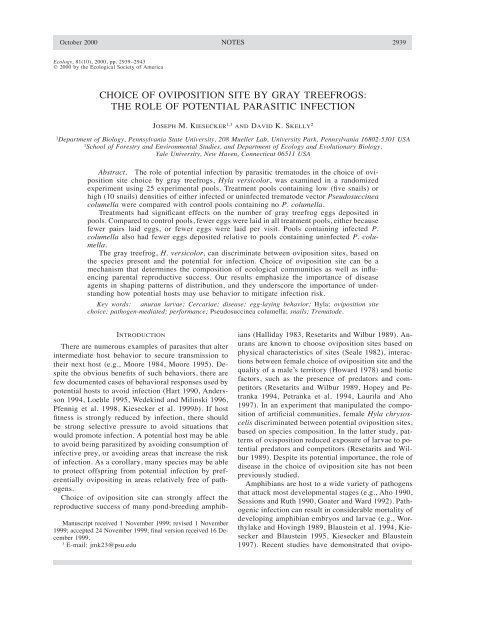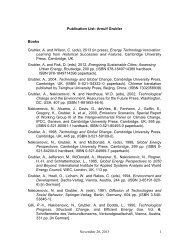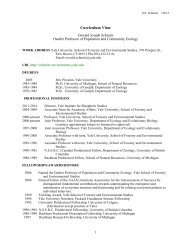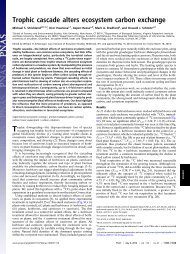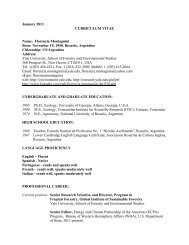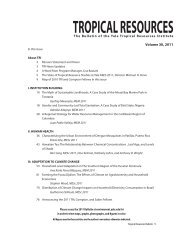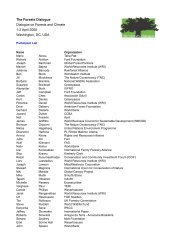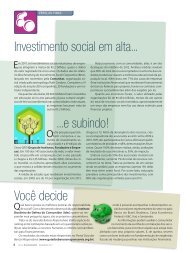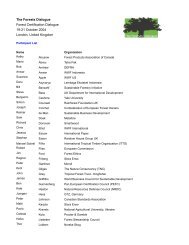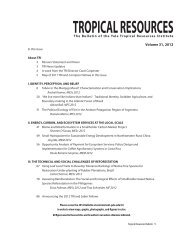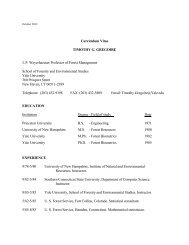Kiesecker, J.M., and Skelly, D.K. 2000. Choice of - Yale School of ...
Kiesecker, J.M., and Skelly, D.K. 2000. Choice of - Yale School of ...
Kiesecker, J.M., and Skelly, D.K. 2000. Choice of - Yale School of ...
Create successful ePaper yourself
Turn your PDF publications into a flip-book with our unique Google optimized e-Paper software.
2942 NOTES Ecology, Vol. 81, No. 10<br />
ticular environmental contexts that can have pr<strong>of</strong>ound<br />
impacts on their prospects for survival <strong>and</strong> growth.<br />
While this mechanism could be <strong>of</strong> equal importance to<br />
ecological patterns, it has received far less attention<br />
than evaluations <strong>of</strong> ecological sorting.<br />
Studies <strong>of</strong> amphibians are a case in point. There has<br />
been a large number <strong>of</strong> studies aimed at underst<strong>and</strong>ing<br />
environmental factors that affect postoviposition performance<br />
<strong>of</strong> amphibians (reviewed by Wellborn et al.<br />
1996). However, relatively few studies have focused<br />
on the factors that influence oviposition site choice in<br />
amphibians (Resetarits <strong>and</strong> Wilbur 1989, Hopey <strong>and</strong><br />
Petranka 1994, Petranka et al. 1994, Laurila <strong>and</strong> Aho<br />
1997). These studies have shown that ovipositing<br />
adults use environmental cues to evaluate potential<br />
breeding sites, <strong>and</strong> can respond by not laying eggs<br />
proximal to potential larval predators or competitors.<br />
In this study, we found that selective oviposition<br />
behavior by adults extends to the avoidance <strong>of</strong> infection<br />
risk to <strong>of</strong>fspring. Gray treefrogs laid few eggs in pools<br />
containing snails infected with a trematode known to<br />
infect tadpoles. A previous experiment in artificial<br />
ponds demonstrated that infection with trematodes can<br />
lead to a 40% decline in metamorphic mass <strong>and</strong> a 30%<br />
decline in survival to metamorphosis (J. M. <strong>Kiesecker</strong><br />
<strong>and</strong> D. K. <strong>Skelly</strong>, unpublished manuscript). While the<br />
costs to larvae in natural ponds remain unquantified,<br />
our preliminary results suggest that the benefits <strong>of</strong><br />
avoiding trematode infection could be significant.<br />
Our experimental design allowed us to evaluate the<br />
possibility that adult treefrogs avoid snails regardless<br />
<strong>of</strong> their infection status. While we did find significant<br />
avoidance <strong>of</strong> uninfected snails, there was a stronger<br />
avoidance <strong>of</strong> infected snails. Because snails are potential<br />
competitors with anuran larvae (Holomuzki <strong>and</strong><br />
Hemphill 1996, Lefcort et al. 1999) as well as vectors<br />
<strong>of</strong> infection, the interpretation <strong>of</strong> this pattern will require<br />
further study. Among several possibilities, the<br />
ovipositing tree frogs’ avoidance <strong>of</strong> uninfected snails<br />
could reflect either an avoidance <strong>of</strong> potential competitors,<br />
or an imperfect ability to assess the infection<br />
status <strong>of</strong> snails.<br />
The specific mechanisms that gray treefrogs used to<br />
detect potential infection is unknown. Snails could be<br />
readily seen within the ponds, suggesting that visual<br />
cues could be involved in their detection. However, it<br />
is difficult to detect cercariae with the naked eye, <strong>and</strong><br />
thus unlikely that visual cues are used to detect differences<br />
between infected <strong>and</strong> uninfected snails. This<br />
suggests that chemical or mechanical cues may be the<br />
primary means for gray treefrog adults to detect infection.<br />
Chemical cues are known to play important<br />
roles in predator recognition <strong>of</strong> larval amphibians (e.g.,<br />
Petranka et al. 1987, <strong>Kiesecker</strong> et al. 1996, Chivers <strong>and</strong><br />
Smith 1998, <strong>Kiesecker</strong> et al. 1999a). In addition, recent<br />
work has demonstrated that larval amphibians are capable<br />
<strong>of</strong> using chemical cues to detect infected conspecifics<br />
(<strong>Kiesecker</strong> et al. 1999b). However, chemically<br />
mediated detection <strong>of</strong> infection by adult amphibians<br />
has not been documented. Alternatively, cercariae may<br />
attack adult frogs, providing a clear indication <strong>of</strong> infection<br />
risk.<br />
Over the last two decades, the study <strong>of</strong> amphibian<br />
communities has been dominated by the evaluation <strong>of</strong><br />
afewfactors(pondpermanence,competition,<strong>and</strong>predation)<br />
in contributing to the sorting <strong>of</strong> species among<br />
ponds (e.g., Wellborn et al. 1996). Experiments have<br />
documented strong support for the roles <strong>of</strong> these factors<br />
in natural communities. However, it is becoming clear<br />
that other variables may have important roles. In this<br />
study, we have found that the risk <strong>of</strong> infection by a<br />
parasite may influence distribution patterns <strong>of</strong> an amphibian.<br />
Preliminary evidence suggests that adult behavior<br />
as well as the impact <strong>of</strong> disease on larval amphibians<br />
may contribute to these patterns.<br />
ACKNOWLEDGMENTS<br />
We thank Stan Sessions, Cheri <strong>Kiesecker</strong>, <strong>and</strong> Heinrich zu<br />
Dohna for providing technical assistance, <strong>and</strong> Terry Malloy,<br />
Charley Malloy <strong>and</strong> Johnny <strong>Skelly</strong> for helpful discussions<br />
regarding experimental design. Hugh Lefcort, Lisa Belden,<br />
Andrew Blaustein, David Pfennig, <strong>and</strong> Richard Howard provided<br />
helpful suggestions on earlier versions <strong>of</strong> this manuscript.<br />
This research was supported by funding from the International<br />
Union for the Conservation <strong>of</strong> Nature, Declining<br />
Amphibian Task Force. J. M. <strong>Kiesecker</strong> was supported by a<br />
Donnelley Postdoctoral Fellowship awarded through the <strong>Yale</strong><br />
Institute <strong>of</strong> Biospheric Studies.<br />
LITERATURE CITED<br />
Aho, J. M. 1990. Helminth communities <strong>of</strong> amphibians <strong>and</strong><br />
reptiles: comparative approaches to underst<strong>and</strong>ing patterns<br />
<strong>and</strong> processes. Pages 157–195 in G. W. Esch, A. O. Bush,<br />
<strong>and</strong> J. M. Aho, editors. Parasite communities: patterns <strong>and</strong><br />
processes. Chapman Hall, New York, New York, USA.<br />
Andersson, M. 1994. Sexual selection. Princeton University<br />
Press, Princeton, New Jersey, USA.<br />
Blankespoor, H. D., <strong>and</strong> R. L. Reimink. 1998. An apparatus<br />
for individually isolating large numbers <strong>of</strong> snails. Journal<br />
<strong>of</strong> Parasitology 84:165–167.<br />
Blaustein, A. R., D. G. Hokit, R. K. O’Hara, <strong>and</strong> R. A. Holt.<br />
1994. Pathogenic fungus contributes to amphibian losses<br />
in the Pacific Northwest. Biological Conservation 67:251–<br />
254.<br />
Chivers, D. P., <strong>and</strong> R. J. F. Smith. 1998. Chemical alarm<br />
signalling in aquatic predator–prey systems: a review <strong>and</strong><br />
prospectus. Ecoscience 5:338–352.<br />
Futuyma, D. J., <strong>and</strong> G. Moreno. 1988. The evolution <strong>of</strong> ecological<br />
specialization. Annual Review <strong>of</strong> Ecology <strong>and</strong> Systematics<br />
19:207–233.<br />
Goater, C. P., <strong>and</strong> P. I. Ward. 1992. Negative effects <strong>of</strong> Rhabdias<br />
bufonis (Nematoda) on the growth <strong>and</strong> survival <strong>of</strong><br />
toads (Bufo bufo). Oecologia 89:161–165.<br />
Halliday, T. R. 1983. The study <strong>of</strong> mate choice. Pages 3–32<br />
in P. Bateson, editor. Mate choice. Cambridge University<br />
Press, Cambridge, UK.<br />
Hart, B. J. 1990. Behavioral adaptations to pathogens <strong>and</strong>
October 2000 NOTES<br />
2943<br />
parasites: five strategies. Neuroscience <strong>and</strong> Biobehavioral<br />
Reviews 14:273–294.<br />
Holomuzki, J. K., <strong>and</strong> H. B. Hemphill. 1996. Snail–tadpole<br />
interactions in streamside pools. American Midl<strong>and</strong> Naturalist<br />
136:315–327.<br />
Hopey, M. E., <strong>and</strong> J. W. Petranka. 1994. Restriction <strong>of</strong> wood<br />
frogs to fish free habitats-how important is adult choice.<br />
Copeia 1994:1023–1025.<br />
Howard, R. D. 1978. The influence <strong>of</strong> male-defended oviposition<br />
sites on early embryo mortality in bullfrogs. Ecology<br />
59:789–798.<br />
<strong>Kiesecker</strong>, J. M., <strong>and</strong> A. R. Blaustein. 1995. Synergism between<br />
UV-B radiation <strong>and</strong> a pathogen magnifies amphibian<br />
embryo mortality in nature. Proceedings <strong>of</strong> the National<br />
Academy <strong>of</strong> Sciences, USA. 92:11049–11052.<br />
<strong>Kiesecker</strong>, J. M., <strong>and</strong> A. R. Blaustein. 1997. Influences <strong>of</strong><br />
egg laying behavior on pathogenic infection <strong>of</strong> amphibian<br />
eggs. Conservation Biology 11:214–220.<br />
<strong>Kiesecker</strong>, J. M., <strong>and</strong> A. R. Blaustein. 1999. Pathogen reverses<br />
competition between larval anurans. Ecology 80:<br />
2442–2448.<br />
<strong>Kiesecker</strong>, J. M., D. P. Chivers, <strong>and</strong> A. R. Blaustein. 1996.<br />
The use <strong>of</strong> chemical cues in predator recognition by western<br />
toad tadpoles. Animal Behavior 52:1237–1245.<br />
<strong>Kiesecker</strong>, J. M., D. P. Chivers, A. Marco, C. Quilchano, M.<br />
T. Anderson, <strong>and</strong> A. R. Blaustein. 1999a. Identification<strong>of</strong><br />
adisturbancesignalinlarvalred-leggedfrogs(Rana aurora).<br />
Animal Behaviour 57:1295–1300.<br />
<strong>Kiesecker</strong>, J. M., D. K. <strong>Skelly</strong>, K. H. Beard, <strong>and</strong> E. Preisser<br />
1999b. Behavioralreduction<strong>of</strong>infectionrisk.Proceedings<br />
<strong>of</strong> the National Academy <strong>of</strong> Sciences, USA 96:9165–9168.<br />
Laurila, A., <strong>and</strong> T. Aho. 1997. Do female common frogs<br />
choose their breeding habitats to avoid predation in tadpoles?<br />
Oikos 78:585–591.<br />
Lefcort, H., S. M. Thomson, E. E. Cowles, H. L. Harowicz,<br />
B. M. Livaudais, W. E. Roberts, <strong>and</strong> W. F. Ettinger. 1999.<br />
Ramifications <strong>of</strong> predator avoidance: predator <strong>and</strong> heavymetal-mediated<br />
competition between tadpoles <strong>and</strong> snails.<br />
Ecological Applications 9:1477–1489.<br />
Loehle, C. 1995. Social barriers to pathogen transmission in<br />
wild animal populations. Ecology 76:326–335.<br />
Moore, J. 1984. Parasites that change the behavior <strong>of</strong> their<br />
host. Scientific American 250:82–89.<br />
Moore, J. 1995. The behavior <strong>of</strong> parasitized animals.<br />
BioScience 45:89–96.<br />
Paine, R. T. 1966. Foodweb complexity <strong>and</strong> species diversity.<br />
American Naturalist 100:65–75.<br />
Petranka, J. W., M. E. Hopey, B. T. Jennings, S. D. Baird,<br />
<strong>and</strong> S. J. Boone. 1994. Breeding segregation <strong>of</strong> wood frog<br />
<strong>and</strong> American toads: the role <strong>of</strong> interspecific tadpole predation<br />
<strong>and</strong> adult choice. Copeia 1994:691–697.<br />
Petranka, J. W., L. B. Kats, <strong>and</strong> A. Sih. 1987. Predator–prey<br />
interactions among fish <strong>and</strong> larval amphibians: use <strong>of</strong><br />
chemical cues to detect predatory fish. Animal Behaviour<br />
35:420–425.<br />
Pfennig, D. W., S. Ho, <strong>and</strong> E. A. H<strong>of</strong>fman. 1998. Pathogen<br />
transmission as a selective force against cannibalism. Animal<br />
Behaviour 55:1255–1261.<br />
Resetarits, W. J., <strong>and</strong> H. M. Wilbur. 1989. <strong>Choice</strong> <strong>of</strong> oviposition<br />
site by Hyla chrysoscelis: role<strong>of</strong>predators<strong>and</strong><br />
competitors. Ecology 70:220–228.<br />
Schell, S. C. 1985. Trematodes <strong>of</strong> North America. University<br />
<strong>of</strong> Idaho Press, Moscow, Idaho, USA.<br />
Seale, D. B. 1982. Physical factors influencing oviposition<br />
by the woodfrog, Rana sylvatica, inPennsylvania.Copeia<br />
1982:627–635.<br />
Sessions, S. K., <strong>and</strong> S. B. Ruth. 1990. Explanation for naturally<br />
occurring supernumerary limbs in amphibians. The<br />
Journal <strong>of</strong> Experimental Zoology 254:38–47.<br />
Tilman, D. 1982. Resource competition <strong>and</strong> community<br />
structure. Princeton University Press, Princeton, New Jersey,<br />
USA.<br />
Wedekind, C., <strong>and</strong> M. Milinski. 1996. Do three-spined sticklebacks<br />
avoid consuming copepods, the first intermediate<br />
host <strong>of</strong> Schistocephalus solidus? Anexperimentalanalysis<br />
<strong>of</strong> behavioural resistance. Parasitology 112:371–383.<br />
Wellborn, G. A., D. K. <strong>Skelly</strong>, <strong>and</strong> E. E. Werner. 1996. Mechanisms<br />
creating structure across a freshwater habitat gradient.<br />
Annual Review <strong>of</strong> Ecology <strong>and</strong> Systematics 27:337–<br />
363.<br />
Worthylake, K. M., <strong>and</strong> P. Hovingh. 1989. Mass mortality <strong>of</strong><br />
salam<strong>and</strong>ers (Ambystoma tigrinum) bybacteria(Acinetobacter)<br />
inanoligotrophicseepagemountainlake.Great<br />
Basin Naturalist 49:364–372.


